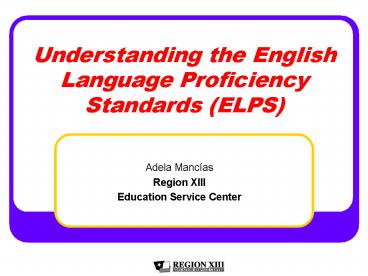Understanding the English Language Proficiency Standards ELPS PowerPoint PPT Presentation
1 / 27
Title: Understanding the English Language Proficiency Standards ELPS
1
Understanding the English Language Proficiency
Standards (ELPS)
- Adela Mancías
- Region XIII
- Education Service Center
2
English Language Proficiency Standards (ELPS)
- Statutory Requirement
- 19 Texas Administrative Code 74.4
- Chapter 74. Curriculum Requirements
- Subchapter A. Required Curriculum
- 74.4
- English Language Proficiency Standards
- Approved November 16, 2007
- Take the place of the ESL TEKS.
3
ELPS English Language Proficiency Standards
- Introduction
- School District Responsibilities
- Cross Curricular Second Language Acquisition
Essential Knowledge and Skills - Proficiency Level Descriptors
4
ELPS The BIG Ideas
- Linguistically accommodated instruction
- Develop listening, speaking, reading and writing
skills in English - Language proficiency levels (beginning,
intermediate, advanced, advanced high)
5
BIGGER Idea.
- ACADEMIC SUCCESS
- for
- English Language Learners
6
A. Introduction
- ELPS are part of required curriculum
- ELL need to know social and academic language
- Integrate second language acquisition with
content area instruction for all language skills - ELLs must read, write, listen and speak with
increasing complexity - ELPS SEs apply K-12
- Level descriptors serve as a road map
7
B. School Districts Shall
- Identify students proficiency levels
- Provide linguistically accommodated, grade
appropriate content instruction - Provide linguistically accommodated content based
language instruction - Targeted language instruction for beginning and
intermediate ELLs (3-12)
8
Cross-curricular Second Language Acquisition
Essential Knowledge and Skills
- 1. Language learning strategies
- 2. Listening
- 3. Speaking
- 4. Reading
- 5. Writing
9
ELPS (d) Proficiency Level Descriptors
- Kindergarten12th Grade ELLs may be at the
- Beginning
- Intermediate
- Advanced
- Advanced high
- Stages of English language acquisition in
- Listening
- Speaking
- Reading
- Writing
10
Connections to TELPAS
- Texas English Language Proficiency Assessment
System - TELPAS assesses the English language proficiency
in listening, speaking, reading and writing of
K-12 ELLs - TELPAS measures how well ELLs understand and use
English for everyday use and academic purposes.
11
Connection to TELPAS
- Students rated by teachers using a rubric for
listening, speaking and writing. - Reading TELPAS exam is administered.
- TELPAS reports four English language proficiency
levels - Beginning
- Intermediate
- Advanced
- Advanced High
- Meets Requirements of NCLB
12
What should administrators do about the ELPS?
- Provide staff development to help teachers learn
to - Identify language proficiency levels of the ELLs
in their classes. - Use the ELPS in planning and instruction to help
ELLs develop their listening, speaking, reading
and writing skills in English in all content
areas.
13
What should teachers do about the ELPS?
- Be aware and knowledgeable of ELLs English
proficiency levels in listening, speaking,
reading and writing - Plan and differentiate instruction based on
students language proficiency levels. - Use ELPS to help ELLs develop their listening,
speaking, reading and writing skills in English
during content instruction - Write language objectives along with content
objectives
14
Essential Question How can I help ELLs attain
social and academic English?
- Make a commitment for all students to develop
academic language during every lesson. - Identify language attainment goals for each
student - Create language objectives
- Plan and provide linguistically accommodated
content-based instruction
15
How is Learning to Swim Like Learning a Second
Language??
16
How is Learning to Swim Like Learning a Second
Language??
- First
- Diving in can be very
- Scary!
17
How is Learning to Swim Like Learning a Second
Language??
- In the BEGINNING
- You start out in the
- shallow end.
- You teach every step
- thoroughly and explicitly.
- What and how well your
- students learn now, will
- determine how strong
- swimmers they will become.
18
How is Learning to Swim Like Learning a Second
Language??
- As they gain proficiency,
- and enter the
- INTERMEDIATE level,
- they still need lots of
- support and
- direct instruction.
19
How is Learning to Swim Like Learning a Second
Language??
- They need time
- and practice.
- Lots
of support. -
Modeling and -
Direct - INTENTIONAL
-
INSTRUCTION
20
How is Learning to Swim Like Learning a Second
Language??
- Lots of opportunities to practice in a safe,
supportive environment.
21
How is Learning to Swim Like Learning a Second
Language??
- Careful monitoring
- watching for warning signs
- of students becoming
overwhelmed.......
22
How is Learning to Swim Like Learning a Second
Language??
- Provide scaffolding to help them build on what
they know to help them understand and internalize
new knowledge and skills.
23
How is Learning to Swim Like Learning a Second
Language??
- As they become
- more ADVANCED,
- they will become
- more independent.
24
How is Learning to Swim Like Learning a Second
Language??
- They still need
- occasional support.
25
How is Learning to Swim Like Learning a Second
Language??
- ELLs are considered ADVANCED HIGH when they need
minimal support to work along with native English
speakers.
26
How is Learning to Swim Like Learning a Second
Language??
- Just like the
natives!!!
27
ELPS English Language Proficiency Standards
- http//www.tea.state.tx.us/sboe/schedule/2007/
- november/instruction/attachments/1_elps_a2.pdf

